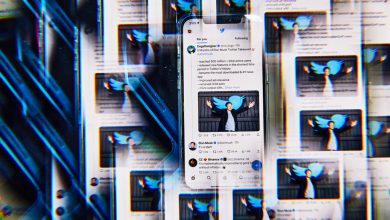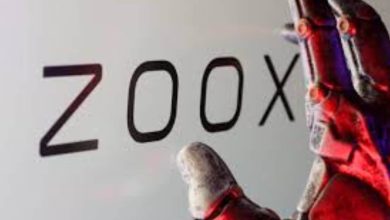The photo booth gets a rebirth in Bengaluru… with an Apple QuickTake 100 camera | Technology News
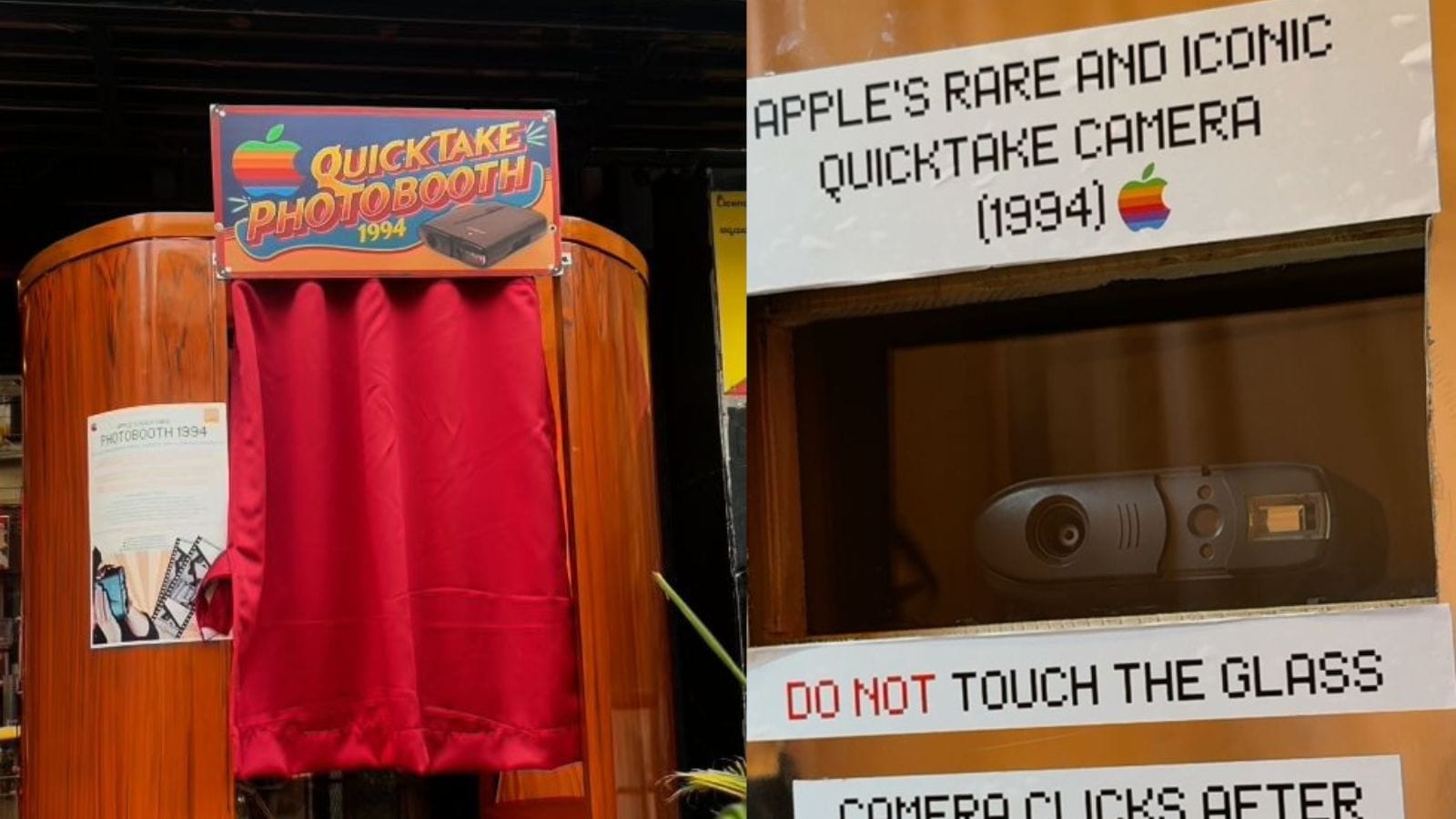
During the opening credit sequence of the 1983 movie Superman III, Christopher Reeve’s character, Clark Kent, runs into a photo booth, which captured his true identity and transformation into Superman. The four black-and-white photos—or strips, as they are commonly known—show the full sequence of Kent removing his glasses and changing out of his civilian clothes to reveal his superhero costume underneath.
He then tore off the bottom photo and handed it to a kid, preventing his identity from being discovered. Many still remember the movie, especially this sequence, which highlights the photo booth and the time when such booths were a common sight across the US. Decades later, photo booths have become a rare sight, with only a few hundred still in existence. However, they are making an unexpected comeback in Bengaluru.
Inside the photo booth, which recently made its debut at the BOHO pub in Bengaluru, India. (Image credit: K Karthik)
K. Karthik, a 23-year-old computer science graduate, has set up India’s first vintage photo booth in Koramangala, Bengaluru, using the QuickTake 100—Apple’s first digital camera and one of the first digital cameras available to the general public in the early ’90s. The photo booth, which was installed at BOHO Pub in Bengaluru earlier this month, aims to revive and preserve the charm of photo booths for the public, offering an authentic experience and a fun way to capture memories.
“My first exposure to photo booths was watching them in classic Hollywood movies, and it was only last year that I visited a photo booth at Bengaluru’s Vega City Mall,” Karthik told indianexpress.com in an exclusive interview. “However, the photo booth was completely modernised, and an iPad was being used as the camera.” But Karthik had long dreamed of having a photo booth in the city he grew up in—one that tells a story and takes people back in time.
The first patent for a photo booth—a self-operating photo machine—was filed in 1888, but it was never built. The following year, in 1889, the earliest concept of a photo booth was introduced by French inventor T.E. Enjalbert at the Paris World’s Fair. It was a coin-operated photo booth that could produce a photo transferred onto a thin sheet of metal in just five minutes, but the machine was met with a lukewarm response.

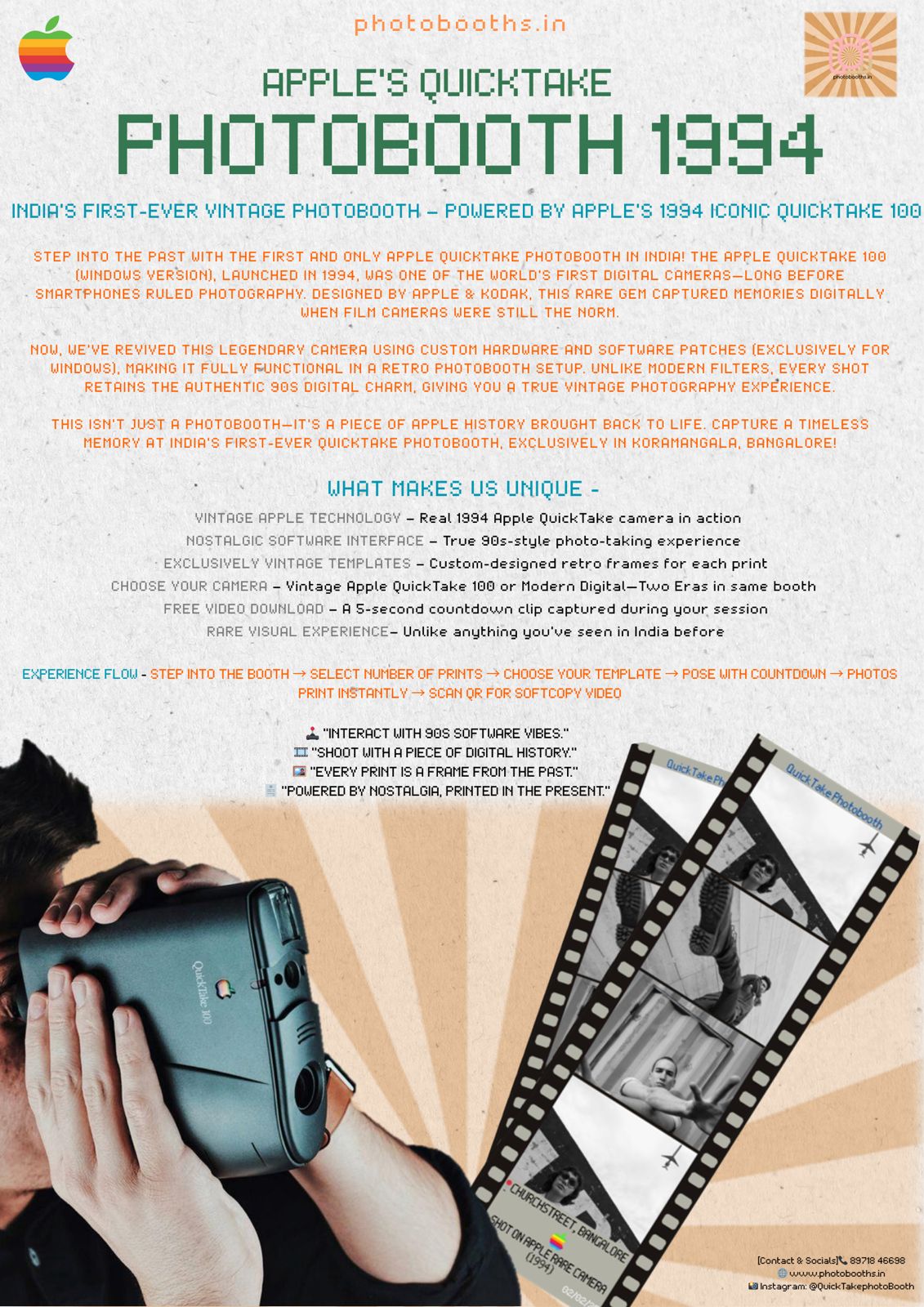 Significant changes were made to use the Apple QuickTake 100 camera with modern technology. (Image credit: K Karthik)
Significant changes were made to use the Apple QuickTake 100 camera with modern technology. (Image credit: K Karthik)
Around the same time, the “Auto-Photo” was patented, though it required an entire room and a small team to operate. In 1912, a more compact design was revealed—the Ashton-Wolff automatic photo machine. However, it required patrons to sit in front of a bulky, box-like device, have their portrait snapped, and wait four minutes for their picture to develop.
The credit for inventing the modern photo booth goes to Anatol Josephewitz, a Russian Jew from Siberia who immigrated to the United States. Always drawn to cameras and photography as a child, Josephewitz was trained as a photographer and, before arriving in the US., began his career working in photo studios—even setting up his own in the early years.
Story continues below this ad
It was Hollywood and Los Angeles that initially drew Josephewitz to the US, but no one could have predicted that the young immigrant carried with him an idea that would democratise photography: an automated photo booth for the masses. To realise his dream, Josephewitz travelled to New York and, in March 1925, filed a patent for a “Developing apparatus for photographic film strips.”
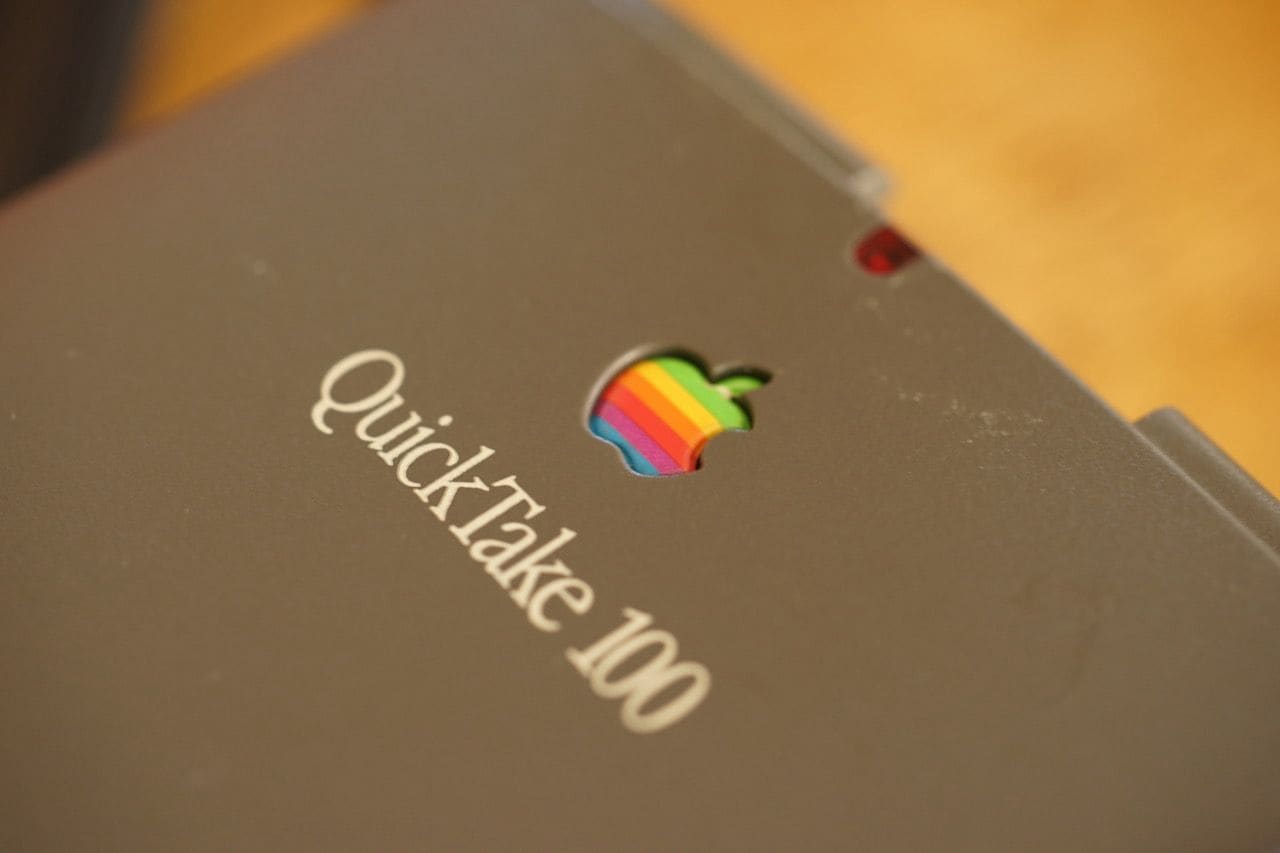 Apple QuickTake 100, a digital camera, was first released in 1994. (Image credit: K Karthik)
Apple QuickTake 100, a digital camera, was first released in 1994. (Image credit: K Karthik)
Originally called the Photomaton, the first booth debuted in New York in September 1925, when Josephewitz opened his Photomaton Studio on Broadway, just a few blocks from Times Square. His photo booth could develop eight photos in eight minutes. The response was overwhelming—his studio attracted thousands of customers, and meeting the demand became a challenge.
In 1927, Josephewitz sold the North American rights to his invention for $1 million to a business group led by Henry Morgenthau Sr., a prominent Jewish New Yorker. By the end of the Second World War, there were over 30,000 functioning photo booths in the US. By the mid-20th century, photo booths had become a cultural phenomenon, appearing in movies and TV shows and becoming a lasting part of popular culture.
When digital technology arrived, many companies began to give up on analogue photo booths as instant digital printouts became the norm. It is estimated that fewer than 200 analogue photo booths remain in the US while many others maintain a retro look on the outside but have been fitted with digital components inside.
Story continues below this ad
For Karthik, the real challenge was finding an analogue photo booth in India, as there were no traditional photo booths in the country. While sourcing an analogue photo booth was nearly impossible, so he took a middle path. “We weren’t able to get back the exact hardware components. But at least, in terms of looks, we wanted something that closely resembled photo booths from the 1970s or 1980s,” he said.
“We searched in Chennai, Delhi, Karnataka, and Andhra Pradesh to develop a photo booth that would replicate the design of those from the 1970s. I contacted more than 30 manufacturers, but all of them declined—except for one manufacturer from Chennai, near the Karnataka border, who agreed and created a vintage-style photo booth for us.”
“We made sure that the ambience, both inside and outside, looked exactly like it did in the 1970s, including the posters,” he added.
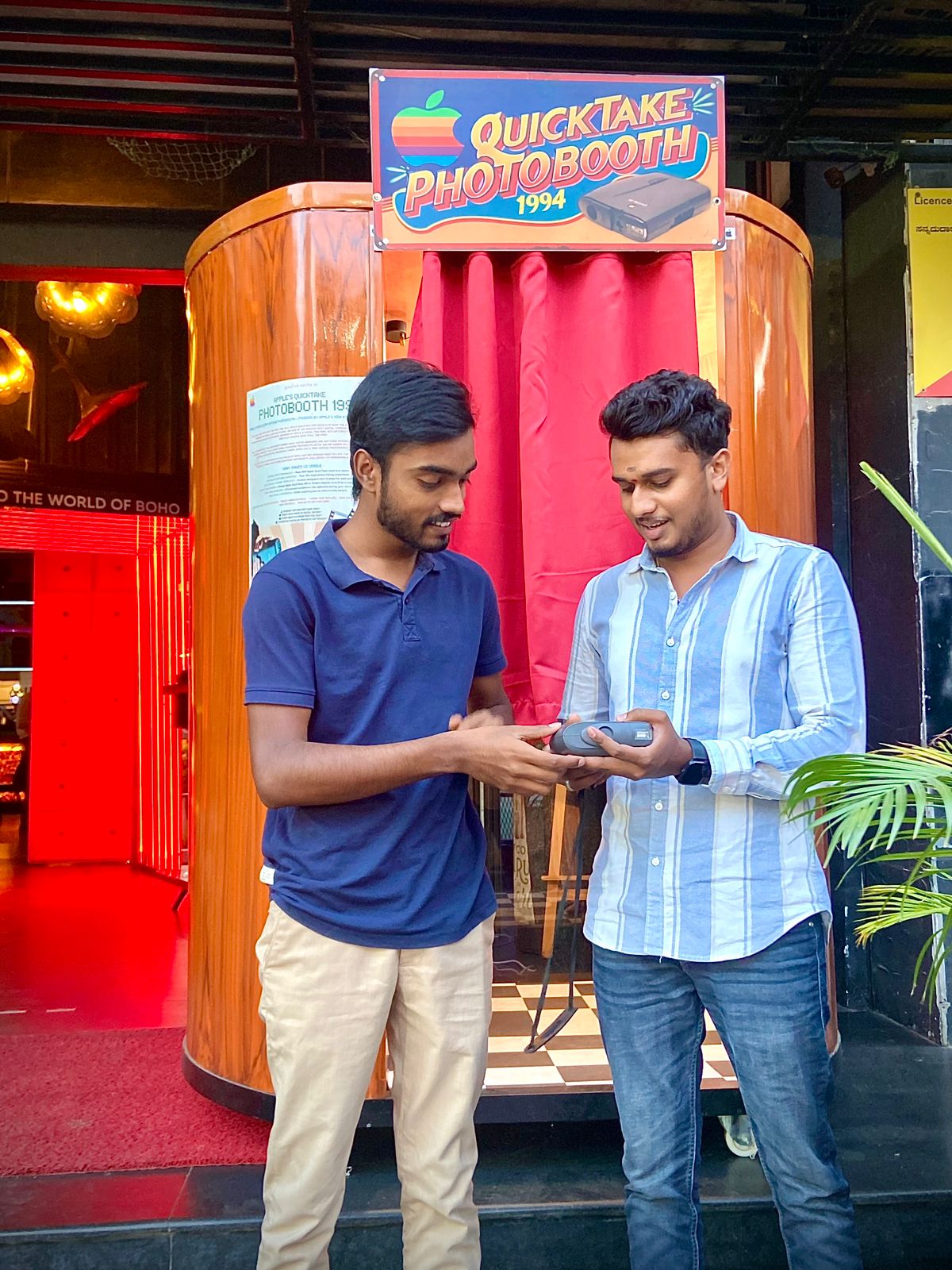 K Karthik (left) can be seen holding the Apple QuickTake 100 in front of the photo booth. (Image credit: K Karthik)
K Karthik (left) can be seen holding the Apple QuickTake 100 in front of the photo booth. (Image credit: K Karthik)
Karthik then chose the Apple QuickTake 100, a digital camera built in collaboration with Kodak. It was launched in 1994, long before digital cameras became mainstream. The QuickTake 100 shot 0.31 MP (640×480) photos in 24-bit colour and retailed for $749. It may not look impressive now, but at the time, it was both technically advanced and affordable.
The camera itself resembles a pair of binoculars, with a design that is unconventional and different from traditional cameras. The QuickTake 100 came with a viewfinder and an LCD panel, and you could control various features using the small buttons around the LCD. Three buttons controlled the flash, resolution, and timer, while a fourth recessed button was used to delete all images at once. It features a front slider that reveals an 8mm fixed-focus lens, equivalent to a 50mm lens on a 35mm camera. The aperture ranges from f/2.8 to f/16, and the focus ranges from four feet to infinity. The shutter speed ranges from 1/30 to 1/175 seconds, and the ISO is approximately 85.
Story continues below this ad
The QuickTake 100 was launched at a time when Steve Jobs had long been gone from the company he co-founded, and Apple had no clear direction, with Cupertino trying its hand at everything. While many today don’t remember the QuickTake 100, it was the camera that brought digital photography into focus. These days, the QuickTake 100 ranks high in collectibility among vintage Apple collectors.
Karthik, who is a vintage collector himself, said he found something truly distinct about the QuickTake 100. Although it’s not an analogue camera, it holds significant historical value. And while very few people in India have been exposed to the QuickTake 100, the Apple brand has a strong recall value. He felt it would be great to modernise the concept of a photo booth for a younger generation while preserving the authenticity and vintage experience.
However, finding the QuickTake 100 was not easy. When the original QuickTake 100 was launched, it came only with software compatible with Mac. Later models, however, were released with support for Windows as well. Karthik wanted a Windows compatible version, and it was extremely hard to find.
“I began searching for the QuickTake 100 last year and reached out to a friend who was in the US, pursuing his master’s at Texas State University. I asked him to look for the QuickTake 100, and he found one with Windows support on eBay for $7,” he said.
Story continues below this ad
Once Karthik secured the QuickTake 100, another challenge was making the camera work in a photo booth environment. With the help of a retired software engineer in the US, he built custom software and a hardware interface to make it compatible with modern settings and the entire process took 6 months.
“I thought of getting a Windows laptop from the ’90s, but it wouldn’t run modern software. However, the modified QuickTake 100 I am using can be connected to a Raspberry Pi or any Windows computer,” he said.
“Once you enter the photo booth and sit inside, you will notice a small screen. Click on ‘Start,’ and then it will ask you to select the number of prints you want. Once that’s done, it takes you directly to the payment gateway. After payment, the camera takes the pictures, and the software places them into a preset template that mimics the 1912 style,” he explains the process of getting the physical photo—or strip—in your hand. Each strip contains four photos, and Karthik charges Rs 199 for two strips.
 Apple QuickTake 100 camera is rare to find these days. (Image credit: K Karthik)
Apple QuickTake 100 camera is rare to find these days. (Image credit: K Karthik)
He says the software has been customised to replicate the 1912 style in every template, and he uses a DNP printer to reproduce the print quality of the original photo booths from back in the day.
Story continues below this ad
Karthik says the initial feedback has been encouraging. He calls it a “fun project,” but he is already planning to set up another booth on Church Street/MG Road in Bengaluru and is currently scouting for another Apple QuickTake 100 camera from the US or Canada. His revenue model includes a profit-sharing arrangement with the venue hosting the photo booth.
With photo booths now over 100 years old, and despite the availability of smartphones and digital cameras, Karthik still believes photo booths will continue to exist—perhaps not in their original form, but adapted for a modern context. Nostalgia and the unique user experience are what keep photo booths alive, serving as a testament to the origins of a revolutionary invention that changed the way we capture moments.

